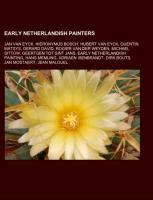Early Netherlandish painters
BücherAngebote / Angebote:
Source: Wikipedia. Pages: 70. Chapters: Jan van Eyck, Hieronymus Bosch, Hubert van Eyck, Quentin Matsys, Gerard David, Rogier van der Weyden, Michael Sittow, Geertgen tot Sint Jans, Early Netherlandish painting, Hans Memling, Adriaen Isenbrandt, Dirk Bouts, Jan Mostaert, Jean Malouel, André Beauneveu, Barthélemy d'Eyck, Joachim Patinir, Petrus Christus, Simon Marmion, Robert Campin, Melchior Broederlam, Master of Saint Giles, Limbourg brothers, Ambrosius Benson, Henri Bellechose, Jacob Cornelisz van Oostsanen, Master of the Morrison Triptych, Colijn de Coter, Juan de Flandes, Josse Lieferinxe, Cornelis Engebrechtsz., Justus van Gent, Jean Clouet, Anthonie van Montfoort, Jean Hey, Hugo van der Goes, Jacques Daret, Albert van Ouwater, Jacob van Utrecht, Dirck Barendsz, Antwerp Mannerism, Master of Affligem, Jan Provoost, Master of the Embroidered Foliage, Jan Mertens the Younger, Hendrick Van Cleve, Lucas Cornelisz de Kock, Aelbrecht Bouts, Master of the Female Half-Lengths, Master of Zweder van Culemborg, Master of the Legend of Saint Lucy, Jan van Coninxloo, Joos de Beer, Jan van Dornicke, Pieter Claeissens the Elder, Jan Crans, Jan de Beer, Jean de Looz, Lucas Adriaens. Excerpt: Jan van Eyck (or Johannes de Eyck) (Dutch pronunciation: ) (before c. 1395 - before 9 July 1441) was a Flemish painter active in Bruges and considered one of the best Northern European painters of the 15th century. There is a common misconception, which dates back to the sixteenth-century Vite of the Tuscan artist and biographer Giorgio Vasari, that Jan van Eyck invented oil painting. Oil painting as a technique for painting wood statues and other objects is much older, and Theophilus (Roger of Helmarshausen?) clearly gives instructions for oil-based painting in his treatise, On Divers Arts, written in 1125. It is however true that the van Eyck brothers were among the earliest Early Netherlandish painters to use it for very detailed panel paintings, and that they achieved new and remarkable effects through the use of glazes, wet-on-wet and other techniques. Thus, because of his early mastery of the technique, he was traditionally known as the "father of oil painting." Jan van Eyck has often been linked as brother to painter and peer Hubert van Eyck, because both have been thought to originate from the same town, Maaseik in Limburg (Belgium). Another brother, Lambert van Eyck is mentioned in Burgundian court documents, and there is a conjecture that he too was a painter, and that he may have overseen the closing of Jan van Eyck's Bruges workshop. Another significant, and rather younger, painter who worked in Southern France, Barthélemy van Eyck, is presumed to be a relation. The date of van Eyck's birth is not known. The first existing record of van Eyck is from the court of John of Bavaria at The Hague, where payments were made to Jan van Eyck between 1422 and 1424 as court painter, with the court rank of valet de chambre, and first one and then two assistants. This suggests a date of birth of at the latest 1395 and indeed probably earlier. His apparent age in his probable self-portrait (right) suggests to most scholars an earlier date than 1395. Miniatures in the T
Folgt in ca. 5 Arbeitstagen
